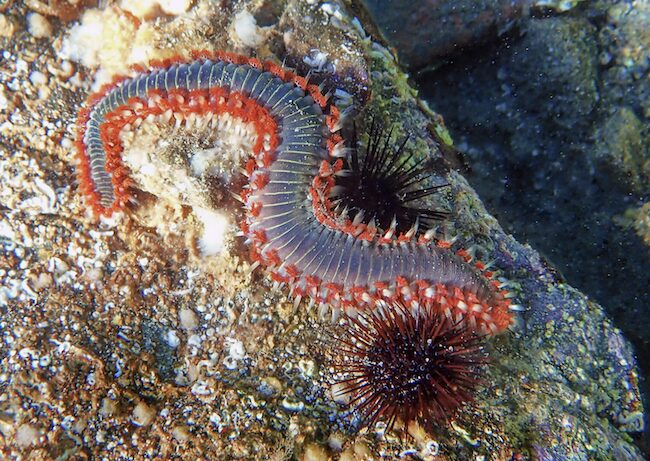Croatia: Fireworm Appears on Croatian Beaches
The bearded fireworm (Hermodice carunculata), sometimes just called “fireworm”, that had previously only been observed in the Mediterranean in southern Italy and off Malta, is now appearing on Croatian beaches.
Published 4 weeks ago
Fireworm Originated in the Caribbean
Originating from the coast of Antigua, an island in the Lesser Antilles in the Caribbean, the bearded fireworm can be found near ocean reefs and at depths of up to 500 feet. They are common throughout the tropical western Atlantic as well as the mid-Atlantic.
In the eastern Atlantic they have been found off the coast of West Africa from Algeria to Liberia and as far the Canary Islands. On the western side from the southeast coast of the United States to Guyana, including the Gulf of Mexico and the Caribbean Sea.
In the Mediterranean the species had only been sighted in southern Italy and off Malta, but are now been reported as appearing on Croatian beaches.
Burning irritation
The bearded fireworm, a so-called polychaete (a segmented worm with bristles and often brightly coloured), owes its name to the fact that its bristles (chaetae) break off easily when touched and release a poisonous secretion. If they penetrate the human skin, they cause a burning pain that can last for several days. The sting can also cause nausea and dizziness.
If you see one of these critters, do not touch them. However, if you do receive a sting, try and remove the bristles. Household vinegar will help, but it is best to seek medical advice.


Population has multiplied
“In the past the Fireworm population was under control around Malta and southern Italy, but with the anomalous waves of heat of the last two to three years they have multiplied to excess and eat everything”, said Italian scientist Michela D’Alessandro, who is studying the species with colleagues Valentina Esposito and Marco Graziano of the National Institute of Oceanography and Experimental Geophysics (Ogs) of Trieste, Italy.
“Now that the water of the Mediterranean is heating, they have increased considerably in the seas of Sicily, Calabria and Puglia, to the point of making it necessary to inform the population and tourists about this new snare. It is a project of the OGS, conducted in collaboration with the Universities of Modena and Reggio Emilia, Catania and Messina, Ispra and the Marine Protected Area of Capo Milazzo.”
…………………………………
Related News:
- Firework is Currently Occuring More Frequently on Croatia Beaches – SeaHelp News
- Voracious and Without Enemies, Heat has Unleashed the Fireworm – ANSA Italy
- Bearded Fireworm Stalks Shallows as Mediterranean Warms – RFI
- The Invasion of Fireworms in Southern Italy’s Seas – Il Messaggero
…………………………………
Related Links:
…………………………………
Noonsite has not independently verified this information.
…………………………………
Find out all news, reports, links and comments posted on Noonsite, plus cruising information from around the world, by subscribing to our FREE monthly newsletter. Go to https://www.noonsite.com/newsletter/.
Related to following destinations: Baska Voda, Betina (Murter), Biograd-na-Moru, Brac, Cariati, Cavtat, Clovo, Cres, Croatia, Crotone, Dubrovnik, Dugi Otok, Elaphite Islands, Gallipoli, Gozo, Grand Harbour, Gzira, Hramina (Murter), Hvar Island, Italy, Jezera (Murter), Kastelanski Zaljev, Komiza (Vis), Korcula, Kornat (Kornati Islands), Le Castella, Luka Peles, Makarska, Mali Losinj (Losinj Island), Malta, Malta, Marina Agana, Marsamxett Harbour, Marsaxlok, Mgarr, Nerezine (Losinj), Northern Islands (Croatia), Northern Mainland (N of Trogir & Split), Novigrad, Olib, Opatija, Orebic, Otok Iz, Piskera (Kornati Islands), Ploce, Podgora, Polace (Mljet), Pomer, Porec, Porto Degli Argonauti, Primosten, Prvic, Pula, Punat (Krk), Rab Town (Rab), Rijeka, Roccella Ionica, Rogoznica, Rovinj, Santa Maria di Leuca, Senj, Sibari, Sibenik, Silba, Simuni (Pag), Skradin, South Coast (Ionian Sea), Southern Islands (Croatia), Southern Mainland (Trogir and southwards), Split, St Julians Bay (Portomaso), Ston, Sukosan, Supetarska Draga (Rab), Taranto, Trget (River Rasa), Trogir, Trpanj, Tucepi, Ugljan, Umag, Veli Iz, Vis Port (Vis), Vodice and Tribunj, Vrsar, Zadar, Zut (Kornati Islands)
Related to the following Cruising Resources: Environment, General, Links to Travel Advice, Medical, Safety and Medical



